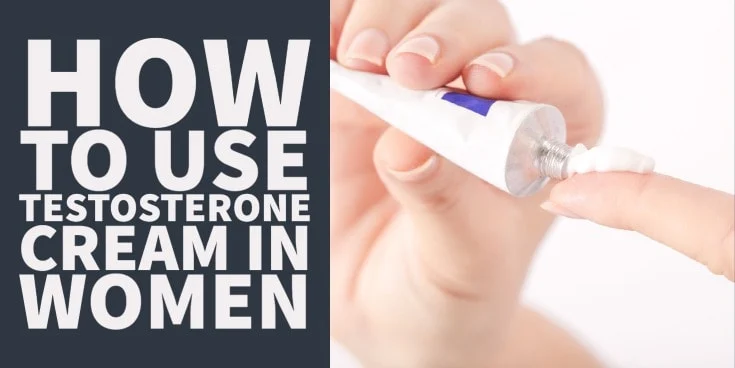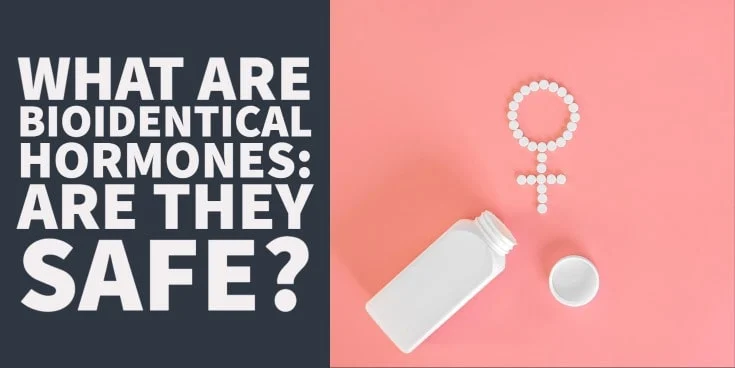Low testosterone can lead to weight gain, changes in mood, decreased energy levels, and a reduction in libido.
What’s more important is this:
Many women suffer from low testosterone and this condition is missed by most physicians.
As a result, it becomes very important for you to understand the signs and symptoms of low testosterone to determine if you would benefit from replacement.
In this article, I’m going to go over why testosterone cream may be one of the best ways to replace low testosterone levels and all of the benefits that you may experience during replacement.
Let’s dive in…
Why you should consider Testosterone Replacement Therapy
Both men and women have and need adequate levels of testosterone.
While men do have more testosterone than women, that doesn’t mean that testosterone isn’t important for women.
In fact:
Women with low testosterone get many of the SAME symptoms that men get when they have low testosterone.
In addition, replacing testosterone is not that difficult and the benefit can be tremendous.
Not only that but the diagnosis and management of low testosterone are often missed/ignored in women due to a general lack of understanding about hormone management by most physicians.
With that in mind let’s go over several reasons that may make you rethink the importance of testosterone for women and consider using it yourself:
#1. Testosterone can help increase libido and sex drive
One of the main reasons that both men and women lose their libido over time is a decline in testosterone.
Testosterone has been shown to INCREASE sex drive (1) and libido in women with low testosterone levels.
Not only does it increase sex drive but it can also reduce the time to orgasm and increase pleasure during intercourse.
To see a full list of therapies that can help improve libido and increase sex drive please read this post.
#2. May improve overall mood, reduce depressive symptoms and reduce irritability
Do you feel yourself getting more irritable as you age? Or that you can’t control your emotions as well as you used to?
Some of these changes may be related to low testosterone levels.
Studies have shown that replacing low testosterone levels can act as an anti-depressant (2).
In addition testosterone in physiologic (normal) dosages actually has a calming effect on the mind and body.
#3. May help increase lean muscle mass and increase metabolism
Supplementing to normal and healthy testosterone levels has been shown to increase lean muscle mass (3) in both men and women.
This has two beneficial side effects:
First, an increase in lean muscle mass helps with weight loss by increasing your metabolism.
Everyone is looking to shed a couple of extra pounds and increasing your metabolism is one way to do this.
A higher metabolism means it takes more energy at rest to eat, breathe and sleep. Much of this metabolism is mediated through your muscle mass.
So higher muscle mass = higher metabolism = more weight loss.
Make sense?
Second, it improves body composition and can tighten up loose skin in certain areas of the female body.
One symptom of muscle mass is “loose skin”, especially in the upper arm area.
As muscle mass declines (termed sarcopenia (4)) and your muscle mass shrink your body will replace that excess space with subcutaneous fat.
This process may result in sagging skin.
Taking testosterone can help replace that lost mass in the skeletal muscle and restore much of the strength that was lost.
This issue is more than just cosmetic.
Reduced muscle mass leads to a higher frequency of falls, inability to maintain balance, and weight gain.
Giving you more than just 1 reason to build those muscles up.
#4. May help with weight loss (especially weight gained after menopause)
This is a big one.
Most women tend to gain weight during menopause (5) (sometimes as much as 15 pounds) and this weight gain is felt to be caused by changes in hormone levels.

At least some (if not a huge portion) of this weight gain is secondary to lower testosterone levels showing the impact that this hormone has on weight.
Replacing testosterone levels isn’t going to be a weight loss miracle pill, but it can certainly go a long way to helping reduce any extra weight that was gained due to its deficiency.
This is one of the reasons that many women opt to use testosterone cream and other forms of testosterone replacement: to lose extra pounds.
This effect on weight loss is probably mediated through the factors we mentioned previously: changes in skeletal muscle mass and metabolism.
Although testosterone also alters energy levels and helps women stay up and active.
#5. May increase or stabilize low energy levels
Testosterone Cream vs Pellets vs Shots
If those benefits listed above were enough to at least pique your interest then keep reading…
There are several factors to consider when replacing testosterone levels and different vehicles to make it happen.
Some methods are definitely better than others so it’s worth discussing each in detail and giving the pros and cons of each.
You can then use this as a general guide to determine which form of testosterone will be best for you.
Note: all of these various methods of giving a person testosterone should ultimately result in an overall increase in testosterone in the body.
Benefits of Testosterone Cream (Including gels/patches as well)
Testosterone cream is probably one of the most common forms of testosterone replacement therapy and for good reason.
When replacing hormones it’s best (whenever possible) to mimic or emulate how the body produces hormones.
This is especially important with testosterone:
In the female body, testosterone is produced by the ovaries and the adrenal glands (6).
This hormone is then dumped directly into the bloodstream (avoiding the GI tract) where it hits target tissues and exerts its effects.
Using testosterone as a cream or anything that goes through the skin closely mimics this natural progression through your body.

This should be compared to taking testosterone (or any other hormone) in a pill or capsule.
By taking it by mouth the hormone is absorbed through the GI tract where it hits the liver and is metabolized FIRST before it can hit all of your target tissues (This phenomenon is well known and called the first-pass effect or first-pass metabolism).
This reduces the potency of the hormone and also may cause dangerous side effects due to potentially harmful breakdown products in the liver.
For this reason, most physicians and patients tend to opt by taking trans-dermal (meaning through the skin) formulations of testosterone.
Using testosterone cream allows for a sustained and controlled release throughout the day that avoids this first-pass effect.
Who should use testosterone cream?
Most women who know they have low testosterone and are experiencing any of the symptoms of low testosterone should at least start with a trial of testosterone cream, gel, or a testosterone patch.
Attempting testosterone cream for at least 2-3 months and checking blood tests at the 6-8 week mark will allow for adequate time to determine if it is working for you.
Pros and cons of using Testosterone cream:
PROS
- Avoids first-pass effect from the liver
- Reduces the number of potentially harmful breakdown products
- Allows for sustained and controlled levels throughout the day
- Most compounding pharmacies should be able to fill your prescription without any issues
CONS
- May require higher doses and changes in dosing over time
- Will require blood tests to measure levels
- Absorption varies between individuals (may work better for some women than others)
- May need to be bound to alcohol to increase absorption
Benefits of Testosterone Shots
Instead of getting testosterone through creams, gels or patches sometimes patients opt to use injections once every week instead.
Using injections is worth considering in the following circumstances:
- You have previously tried and failed testosterone creams
- Your testosterone blood levels are not increasing even after increasing the dose and concentration of your cream
- You haven’t noticed any positive side effects from creams/gels/patches
- You prefer once-a-week dosing over once-daily dosing (or have a hard time remembering to use your testosterone)
- You are having trouble getting your cream/gel/patch prescription filled
Generally, I reserve testosterone injections for patients who fall into the above categories.
The benefit of using shots is that you get a higher concentration of testosterone in one sitting, this makes positive (and potentially negative) side effects easier to identify.
One of the downsides is that testosterone levels peak after days 2-3 of the injection and then slowly fall back down over the next 4-5 days.
This doesn’t allow for the same sustained tissue levels of testosterone that creams/gels allow for.
Having said that some women just do better on testosterone injections vs creams so it is worth considering this option for most women.
Pros and cons of using Testosterone shots:
PROS
- Works better for women with absorption issues
- Usually results in higher doses throughout the day
- Infrequent dosing (only need to use it once per week)
- Avoids first-pass metabolism in the liver and works well
CONS
- Small risk of infection at the injection site
- Lack of control in dosing (easier to take too much compared to creams/gels)
- May have difficulty filling the prescription in your state
- Must inject the hormone into your body (a problem if you have issues with needles)
Pellets and Oral/Sublingual Testosterone
Another commonly used form of testosterone replacement (or other hormones) is through pellets.
Pellets are surgically implanted pellets that contain a high dose of hormones that slowly dissolves over months.
Because of this mechanism, there is far less control over dosing meaning that the dose tends to be either too high (causing negative side effects) or too low (failing to cause positive side effects).
Couple this concern with the fact that you need to undergo a surgical incision to place it in your body and pellets look even worse.
In my experience, it’s far better to use creams/gels/creams/shots over pellets due to these reasons.
You might consider using a pellet if they have previously worked well for you in the past or if you can’t tolerate gels/creams/patches/shots.
Pros and cons of using Testosterone pellets:
PROS
- May work for patients who have failed other forms of testosterone replacement therapy
- Doesn’t require frequent dosing
CONS
- Risk of infection/bleeding at the surgical site
- Decreased control over sustained dosing (if you get too much you can’t change the dose)
- Inability to alter dose easily
- Expensive compared to other forms of testosterone replacement
Diagnosing Low Testosterone
Diagnosing low testosterone is actually not very difficult (we will go over it below).
The hard part is getting the right kind of treatment and the right type/form of medication.
The problem with hormones is that most physicians are not trained on how to replace hormone imbalances and so they don’t appreciate their importance or the benefit they may provide.
As a result, it’s usually better to look for a physician who specializes in hormone replacement therapy for the best results.
Alternatively, if your physician IS willing to work with you, you can simply ask for a couple of tests to determine how your hormones are doing.
To diagnose low testosterone you need to check the following labs:
- Free testosterone (optimal ranges for both below)
- Total testosterone
Ordering the right tests is only half the battle, the other half is understanding how to interpret them correctly.
To illustrate this I’ve included an example of real lab results below…
Example of obviously low testosterone(falling outside of the reference range):

This case is typical and very obvious.
The total testosterone is low at less than 3 with a range of 3-41.
The DHEA (another androgen) is also low at 26.7 with a range of 41.2 – 243.7.
This is an obvious case of low testosterone and if this patient also had symptoms of low testosterone she should consider a replacement regimen.
On the other hand, some patients have what is referred to as “sub-optimal” hormone levels that still technically fall within the “normal” range.
Example of sub-optimal testosterone levels in women (inside the range but still low and needs replacement):

In this example, the free testosterone is sub-optimal at 0.14 with a range of 0.06 – 0.98.
The total testosterone is also sub-optimal at 8.5 with a range of 8 – 60.
This is another example of a patient’s labs that should be treated even though they “technically” fall within the normal ranges.
As a general rule, if you are a woman who is symptomatic with testosterone levels in the bottom 50% of the reference range then you should consider testosterone replacement therapy.
Lab studies you should get checked
When checking your testosterone levels it’s also a good idea to evaluate your other hormone levels.
The reason is simple:
If you have one hormone imbalance, you are much more likely to have other hormone imbalances as well.
Because of this, you should consider getting a complete hormone panel to ensure proper treatment.
I recommend the following labs:
- Testosterone free and total
- Estradiol and progesterone
- Complete thyroid panel (see the link for the complete list)
- DHEA (another important androgen)
- Insulin and leptin (helpful if you have weight issues)
This panel is a great starting point and should allow a full evaluation of your hormone profile.
FAQ about using Testosterone
If you still have questions regarding the use of testosterone please refer to this FAQ.
If you have other questions please feel free to ask them in the comments below and I will be sure to update this list as well.
Where should I apply it?
Testosterone is usually best if applied to the upper/inner arm area.
Any area with high vascularity and low subcutaneous fat will work well but remember you should not use multiple hormones on the same area of skin.
For this reason, I usually recommend that women reserve the forearm area for estrogen/progesterone and use testosterone in the upper arm area.
If you aren’t using other hormones trans-dermally then you can also consider these areas for application: thighs, lower abdomen area, forearms, neck area, and/or vaginal mucosa.
Testosterone can also be applied vaginally (assuming your formulation won’t burn or cause problems) and may be very beneficial especially if you are suffering from low libido or low sex drive.
How long does it take to work?
You should notice an improvement in your symptoms within 4-8 weeks of starting testosterone replacement therapy.
In some cases, women continue to experience slight benefits over the next several months, and some symptoms take time (like building muscle mass), but energy levels and libido should increase within 4-8 weeks.
This assumes that your dose is adequate and that your blood levels of testosterone are increasing on your current dose.
Is it dangerous or are there any side effects?
Testosterone replacement is generally well tolerated.
Symptoms usually occur if the dose of testosterone is too high.
These symptoms include:
- Hormonal or cystic acne (may also increase oil production of the skin)
- Changes in hair growth(facial hair growth or dark/coarse hair growth)
- Changes in mood(usually more irritable)
- Very high increase in libido
If these side effects occur while using testosterone cream or gel then the side effects will fade within days.
If they occur with testosterone pellets then they may take months to improve.
Side effects from testosterone shots should improve within 7 days.
How much should I take & what is the dosage?
Dosing varies on the individual and should be based on a combination of lab tests and symptomatic relief.
The reason for this is the absorption of testosterone depends on the individual, how quickly they metabolize the testosterone and how much their body actually needs.
Because of these reasons, testosterone doses vary from person to person and will require some degree of trial and error (including lab monitoring) to find your specific dose.
Wrapping it Up
Testosterone replacement therapy, specifically testosterone gel or cream, has multiple potential benefits for women including weight loss, increased energy levels, building lean muscle mass, and helping with mood.
When diagnosing low testosterone it’s best to use a combination of lab tests plus symptoms.
Remember to use the “optimal” ranges vs the standard “normal” ranges when determining both if and how much testosterone you may need.
Now it’s your turn:
Are you currently using testosterone gel or cream?
Is it working for you? Why or why not?
Are you planning on getting your testosterone levels checked after reading this?
Are you experiencing any of the symptoms of low testosterone?
Leave your questions or comments below!








